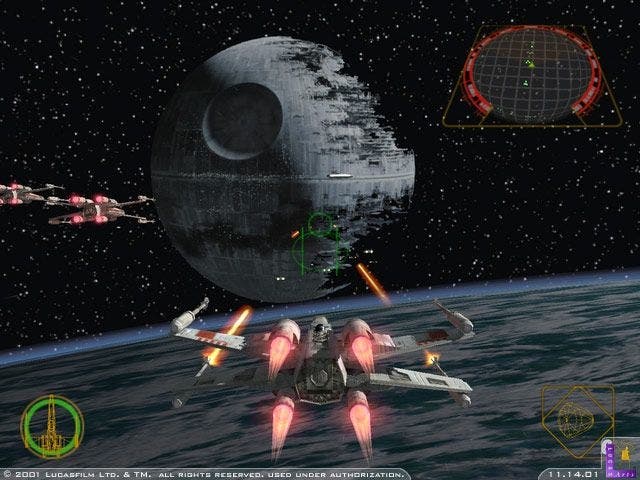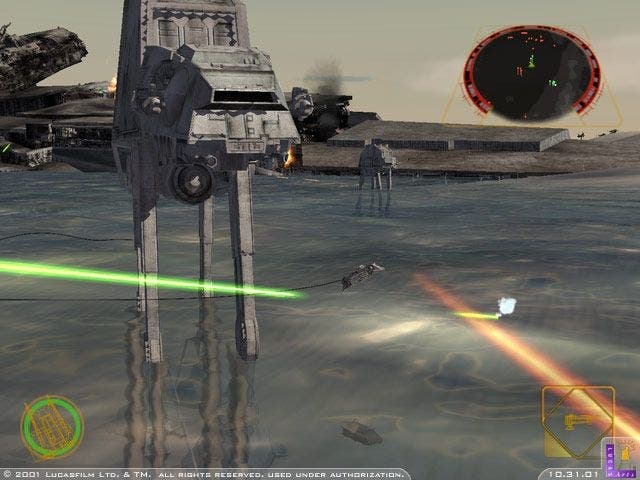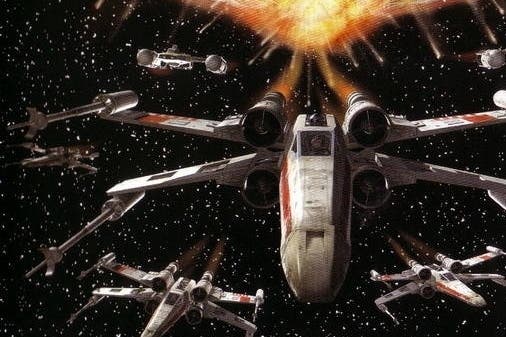Star Wars Rogue Squadron 2: Rogue Leader retrospective
TIEs that bind.
Is it possible to cheat on a console? I don't mean entering the Konami Code or exploiting Game Genie-enabled shortcuts. I'm talking about the rather old-fashioned idea of digital monogamy, of staying true to one machine. Perhaps it's just a cultural hangover from declaring loyalty to either the ZX Spectrum or the Commodore 64, the sort of thing that happened a long time ago in a playground far, far away. Yet it became a pressing issue, personally, in 2002.
Ditching a console that has lost its lustre and shacking up with a younger, slimmer model might not be the height of chivalry, but definitively selling up, making a clean break and moving on at least feels socially acceptable. Juggling two machines of similar tech spec at the same time, though? It was an uncommon domestic situation that, a decade ago, involved a lot more fooling around with the removal and reinsertion of leads in the back of your telly. It seemed a little ... disrespectful.

In 2002, I was in an extremely happy and rewarding relationship with a PlayStation 2. For the most part, it felt like we were in the first flush of romance, exploring an exciting new future together. We held hands (Ico). We had long conversations on the phone (Metal Gear Solid 2: Sons Of Liberty). We were young hearts, running GTA 3. But one day, loitering on a work lunchbreak inside a Virgin Megastore, I had my head turned by a brand-new Nintendo GameCube that was running exclusive launch title Star Wars Rogue Leader 2: Rogue Squadronon an endless loop.
As the Xbox One and PS4 contine to roll out their endless pre-release presentations and sparkly fishing-lure YouTube campaigns, it's worth remembering that not so long ago, gamers mostly had to go on instinct. Back then, it was still possible to stumble across something that wasn't just a game-changer but a console-changer. I'm not talking about the corporate-mandated titles optimistically bundled in with the launch of new hardware to tempt the normals or the neutrals. This would hit you like a thunderbolt. It would likely be a game you saw by happenstance, perhaps round at a friend's house. The sort of singular experience that made you realise that you simply must own this machine so you could recreate it in your own space, at your own pace.
Star Wars Rogue Squadron 2: Rogue Leader was one of those games. From the outset, from that very first lunchbreak, it lit an unquenchable fire in me.
At first, I could feed my addiction in public, staking out the demonstrator pod every lunchtime and looming threateningly over any schoolkids who got there before me. The opening Rogue Leader mission dumped you straight into Luke Skywalker's bright orange flightsuit and the climactic assault on the first Death Star. Immediately, every pretty thing the GameCube was capable of was thrown directly into your face: lethal skirmishing with TIE fighters while approaching the iconic battle station; skimming the surface to neutralise laser towers; hurtling down the famous trench and priming your proton torpedoes for the last-ditch attack run. They even faithfully recreated the targeting computer. It was impossibly exciting.

There had been countless Star Wars games before Rogue Leader. But due to technological limitations, they had all demanded players bring their own imaginations to complete the circuit of enjoyment. Rogue Leader's Nintendo 64 predecessor Star Wars Rogue Squadron was a solid enough arcade-style game, but essentially felt like swooping Lego-brick speeder models through a featureless sandpit and pretending it was Tatooine. Thanks to the GameCube's processing oomph, Rogue Leader oozed with technical verisimilitude. Developers Factor 5 were so confident in their proprietary game engine that the newfound ability to stream video footage was relegated to a literal backseat role; key scenes from the original trilogy burbled in the background as visual wallpaper on menu and status screens.
It had the John Williams music. It had the Ben Burtt sound effects. It had enough raw power to create convincingly crammed asteroid fields, sprawling planetscapes and entire Rebel and Imperial armadas. As far as I was concerned, Rogue Leader was Star Wars, and through sheer novelty alone, the GameCube itself became part of the fantasy. The chunky purple box might not have looked like it was designed by Ralph McQuarrie, but the GameCube's distinctively chunky controller - with its offset secondary yellow joystick that allowed any aspiring X-Wing pilot to look up and around their canopy from a first-person viewpoint - seemed like the sort of doohicky you might have found in an "actual" starfighter. Even the irregular face buttons (marked "A", "B", "X" and "Y") evoked the ship classifications of the Rebel fleet.
So, although I could barely afford or justify it, I bought a GameCube within a fortnight of being exposed to Rogue Leader, despite previously exhibiting no real interest in owning another console. I may have been cheating on my PS2, but I retained some loyalty to that Virgin Megastore, picking up a console bundle for £350, a not inconsiderable sum both then and now. There is certainly a difference between playing in short bursts on a crowded shopfloor and sinking serious hours into a game at home - not least in that, at home, I could actually save my progress on a memory card. But while some contemporary reviewers ultimately found Rogue Leader's 10-mission structure to be too short, I luxuriated in it like galactic bubblebath.

For a licensed property, Rogue Leader plotted a confident course through recreating key scenes from the source material - Death Star! Hoth! Another Death Star! - and creating expanded missions that still felt like they had some bearing on the overarching story. The additional operations were enlivened by some then-quirky effects, such as the time on the GameCube's in-built clock affecting the in-game environment. Some missions took detours into some of the more generic parts of the Star Wars universe, but most gave you a genuine sense of purpose, whether it was heisting the Lambda-class shuttle Tydiriumthat would become so vital in Return Of The Jedi or assisting Bothan spies in retrieving vital intelligence from a shattered Star Destroyer that had ditched on an idyllic beach planet.
The intense arcade dogfighting that comprised most of the action could be toggled smoothly from first-person to third-person, and while tactical options were limited, the primal thrill of drawing a bead on yet another enemy, often playing as trilogy everyman Wedge Antilleshimself, was a ritualised combat loop that never got old. Perhaps it was significant that Rogue Leader recreated the original Star Wars trilogy so evocatively at a time when everyone was trying, and failing, to get excited about the prequels. Racking up significant scores unlocked bonus levels and additional spacecraft in a near-demented splurge of fan service. Eventually, you could relive the Millenium Falcon's escape from the Death Star by blasting TIE fighters from the dorsal turret, a brief but brilliantly-realised experience in which you could swear you heard Han yell: "That's great kid! Don't get cocky ..."
I played Rogue Leader with such intensity that eventually I had to stop. Not because I had exhausted the game's missions or difficulty levels - eventually, you could play as Darth Vader, repelling the Rebellion's initial Death Star assault and demolishing their Aztec-esque stronghold on Yavin IV for a canon-busting thrill. I didn't stop because I was bored with Rogue Leader. I stopped because I played it so long and so hard that when I closed my eyes, I could still see the omnipresent starfield scrolling on my eyelids. My doctor was unimpressed, but that's exactly the sort of all-encompassing experience you need to shift a new machine. As yet, I have not seen a comparable life- and/or health-ruiner among the Xbox One and PS4 launch line-ups.
I cohabited with my GameCube and PS2 for a few years, although gradually there was less and less fumbling round the back of the telly as the Sony console reclaimed its place as my number one. They may not all have had the visceral, sensory overload of Rogue Leader, but the PS2 simply had more games, and had shacked up with more of my friends. It also retained its slinky looks, while the chunky, cheerful Nintendo machine began to look a little childish. Stringing along two consoles at once might not have been my most gallant moment, but eventually I got my cosmic comeuppance. Yet I take little comfort in the fact that I wasn't the only one who had their heart broken into a million tiny pieces by the diabolical Star Wars Rogue Squadron 3: Rebel Strike .

